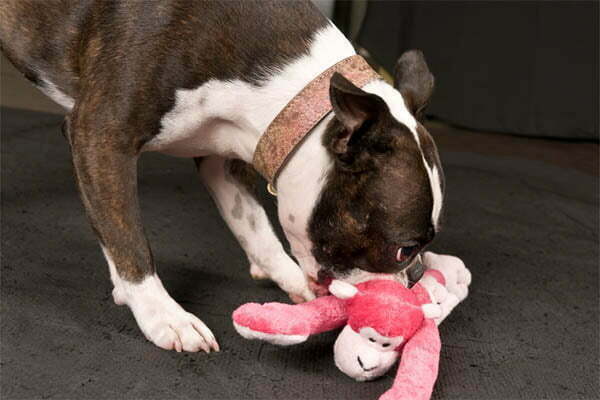
One of my dogs is a toy terror. She can destuff a toy within a few hours of me purchasing it. It seems like she knows exactly where the weak spots are, and she exploits them with surgical precision.
I haven’t got an issue with her breaking them. She gets plenty of enjoyment out of them while they last, so I feel like it’s money well spent.
My issue is with the seemingly endless reams of polyester stuffing that spills out of the poor stuffies. Not only does it get absolutely everywhere, but it doesn’t seem like the type of thing my dog should be eating.
Now, I’m lucky in that my dog prefers to decorate with the stuffing rather than eat it. However, plenty of dog owners despair when they realize their beloved pooch has ingested the toy innards.
It can be a worrying situation that leaves us wondering whether to call the vets or sit and watch. Nobody wants to make the wrong decision in that situation, so what should you do?
Disclaimer
We research all our articles thoroughly to make sure that we are presenting accurate and helpful advice.
However, our articles are not a substitute for professional veterinary advice. If you are concerned about something your dog has eaten, please call your vet.
Veterinary advice and recommendations should always take precedent.
Is Stuffing Safe?
In most cases, the internal stuffing and squeakers of dog toys are not safe for your dog to eat.
Toys that are made specifically for dogs usually use polyester fiber fill. This is the fluffy, stringy stuff that ends up strewn across your house.
It is used because it is safer than alternatives like polyester beads or nutshells. These are often used to stuff toys for older kids.
If you’re going to give your dog a soft toy designed for kids, make sure it is designed for ages 3 and under. These typically avoid beads and shells in the filling.
The problem with polyester fiber fill and cloth toys in general, is that they don’t break down when eaten.
This can lead to intestinal blockages which can, in extreme cases, cause death.
Unfortunately, intestinal blockages are difficult to see or notice without medical intervention. This means that you only really notice when the problem has progressed quite far. In some cases, this can be too late.
This is why it is so important to act fast if you notice that your dog has eaten the polyester fiber fill from their toy.
Another issue with stuffing is that it can choke your dog. The fiber fill is made up of strands of polyester connected together. This can get caught in the dog’s throat or mouth and block their airways.
It is similar to swallowing a strand of spaghetti whole but on a thicker and fluffier scale.
Fiber fill is also very dry which increases the likelihood that your dog will choke on it. The polyester dries up the throat and the esophagus making it harder for your dog to swallow.
What to Do?

How you respond depends on the level of threat your dog is facing. Choking poses an immediate threat to your dog’s life and needs to be dealt with first. The issue of removing ingested stuffing from the stomach becomes a secondary worry when your dog is struggling to breathe.
We’re going to talk you through the process step by step, starting with the most pressing issue. Once you resolve one step you can move on to the next.
Stay Calm
We appreciate that this is incredibly difficult to do, especially if your beloved pet is choking or vomiting. However, panic will only make the situation worse.
Before you dive into the situation, take a quick moment to catch your breath and organize your thoughts.
Now you can continue.
Choking
This is the most immediate threat to your dog. If they are choking on the stuffing, you need to take action right away.
Signs of choking include pawing at the muzzle, hacking or retching, drooling, rubbing the head on the ground, and unconsciousness.
To rectify the situation, you’re going to need to have your hands in and around the mouth. This comes with its own risks as even the most placid dog can bite in a panic.
Where possible, get another person to restrain the dog while you check inside the mouth. You don’t want to put a muzzle on them as this would impede your work. Instead, get them to hold the dog around the body or the shoulders.
Using both hands, open the dog’s jaws. You might need to prize them apart with a small amount of force. Once the jaws are open, adjust your grip so that the dog’s lips cover their teeth. This can help prevent bites.
Look inside the mouth for any stuffing that is still there. Remove it with your fingers. This might be easier if you have another person to hold the mouth open.
Sweep your finger across the back of the mouth but not into the throat. If you feel any stuffing, gently remove it.
Do not try to remove stuffing that is in or near the throat. You may accidentally press it deeper into the throat which would make things worse.
If you’ve not been able to get rid of the blockage with your fingers, you’ll need to use the Heimlich maneuver.
For small dogs, lay them on their back and apply firm pressure to the abdomen below the rib cage. You need to push up towards their chest cavity.
For medium to large dogs, you’ll need to adjust your technique depending on their position.
If they are standing, wrap your arms around their abdomen and join your hands while making a fist. Squeeze tightly pushing your fist up and forward so that it goes just behind the rib cage.
Place the dog on their side after this maneuver.
If the dog is laying down, place one hand on the back and the other on the abdomen below the rib cage. Push up toward the spine with your front hand while using the back hand for support.
After you perform the action, check the mouth for any dislodged stuffing, making sure to sweep the back of the mouth.
If you cannot get the obstruction out, you will need to get emergency help. Ring the vet or emergency clinic and follow their instructions.
Further Heimlich instructions can be found online including video demonstrations.
If you’ve had to perform the Heimlich maneuver, you need to call the vet whether or not it was successful. It is likely that some damage has been done to the throat or the abdomen.
Remove the Toy
If your dog still has the toy or stuffing in their mouth or within their reach, they are still at risk.
Try to remove the toy and stuffing as calmly as you can. If you dive in and try to snatch it away, your dog may reflexively try to swallow or hoard it. They may see it as a game or see you as a threat to their fun.
If your dog is holding the toy, and they know the ‘drop’ command, tell them to drop the toy.
If, however, your dog will not drop the toy, the best thing to do is hold the toy very still while it is in their mouth. Don’t tug or pull as they may think of it as a game, and they’ll hold on tighter.
Grasp both sides of the toy as close to the dog’s mouth as you can and remain still. You are trying to make yourself and the toy as boring as possible. Eventually, the dog should give up.
Once you’ve got a hold of the stuffing and the toy, dispose of them where your dog can’t get them. Don’t place them on the side to move later, or in a bin the dog can access.
Call your Vet
If you’re alone, this step can wait until you’ve dealt with the more pressing issues above. If there are others in the house that can help, get them to call the vet while you go through the first 3 steps. The vet will be able to offer help over the phone.
The reason we’ve put ‘call the vet’ so low on our list of priorities, is that your dog has about 2 hours before the polyester gets to the intestine. Before this point, it won’t be much of a bother, unless they choke on it.
You still need to see your vet as a matter of urgency, but as we said earlier, other situations take precedent.
Your vet will likely run tests and x-rays to determine where the stuffing is. If they think it will pass naturally, you’ll be sent home.
They may decide to induce vomiting at the clinic. This usually happens if the stuffing is still in the stomach. You should not try this at home unless your vet tells you to.
If the stuffing is in the intestine and causing or at risk of causing a blockage, the vet will have to operate. This will be performed under anesthesia and can be quite risky, not to mention expensive.
What to Do If You Didn’t See Them Eat It
If you didn’t see your dog eat the stuffing, but you’ve come home to a destroyed toy, the best thing to do is check with the vet. It is better to be safe than sorry, as the saying goes.
It’s a good idea to have a look around for the stuffing first. This can help you ascertain whether or not your dog has eaten any. However, if you don’t know how much stuffing there was, it’s going to be impossible to know.
Final Thoughts
Prevention is better than cure in this case. Always inspect your dog’s toys for signs of distress and weakness. It’s also a good idea to rotate their toys so that they get a break and are less likely to rip or tear open.
Remember, if you suspect that they have ingested stuffing, call a vet for expert advice.
